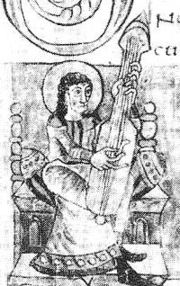Before the development of the electric guitar and the use of synthetic materials, a guitar was defined as being an instrument having "a long, fretted neck, flat wooden soundboard, ribs, and a flat back, most often with incurved sides".[1] Instruments similar to the guitar have been popular for at least 5,000 years. The guitar appears to be derived from earlier instruments known in ancient India and Central Asia as the Sitara. The oldest known iconographic representation of an instrument displaying all the essential features of a guitar being played is a 3300 year old stone carving of a Hittite bard.[2] The modern word, guitar, was adopted into English from Spanish guitarra, derived from the Latin word cithara, which in turn was derived from the earlier Greek word kithara, which perhaps derives from Persian sihtar[3]. Sihtar itself is related to the Indian instrument, the sitar.

The modern guitar is descended from the Roman cithara brought by the Romans to Hispania around 40 AD, and further adapted and developed with the arrival of the four-string oud, brought by the Moors after their conquest of the Iberian peninula in the 8th century.[4] Elsewhere in Europe, the indigenous six-string Scandinavian lut (lute), had gained in popularity in areas of Viking incursions across the continent. Often depicted in carvings c. 800 AD, the Norse hero Gunther (also known as Gunnar), played a lute with his toes as he lay dying in a snake-pit, in the legend of Siegfried.[5] By 1200 AD, the four string "guitar" had evolved into two types: the guitarra morisca (Moorish guitar) which had a rounded back, wide fingerboard and several soundholes, and the guitarra latina (Latin guitar) which resembled the modern guitar with one soundhole and a narrower neck.[6]

The Spanish vihuela or "viola da mano", a guitar-like instrument of the 16th century, appears to be an aberration in the transition from the renaissance instrument to the modern guitar. It had lute-style tuning and a guitar-like body. Its construction had as much in common with the modern guitar as with its contemporary four-course renaissance guitar. The vihuela enjoyed only a short period of popularity; the last surviving publication of music for the instrument appeared in 1576. It is not clear whether it represented a transitional form or was simply a design that combined features of the Arabic oud and the European lute. In favor of the latter view, the reshaping of the vihuela into a guitar-like form can be seen as a strategy of differentiating the European lute visually from the Moorish oud.
The Vinaccia family of luthiers is known for developing the mandolin, and may have built the earliest extant six string guitar. Gaetano Vinaccia (1759 - after 1831)[7] has his signature on the label of a guitar built in Naples, Italy for six strings with the date of 1779.[8][9] This guitar has been examined and does not show tall-tale signs of modifications from a double-course guitar although fakes are known to exist of guitars and identifying labels from that period.
Modern dimensions of the classical instrument were established by Antonio Torres Jurado (1817-1892), working in Seville in the 1850s. Torres and Louis Panormo of London (active 1820s-1840s) were both responsible for demonstrating the superiority of fan strutting over transverse table bracing.[10]
The electric guitar was patented by George Beauchamp in 1936. Beauchamp co-founded Rickenbacher which used the horseshoe-magnet pickup. However, it was Danelectro that first produced electric guitars for the wider public.

No comments:
Post a Comment